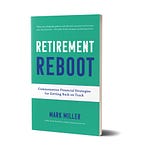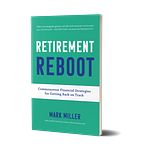
Source: AARP
This week on the podcast, we consider this startling question: What would happen to Social Security if we eliminate its funding?
That’s the question I’m asking myself following Donald Trump’s presidential memorandum last weekend ordering the deferral through year-end of revenue collected under the Federal Insurance Contributions Act - better known as the payroll tax - that funds Social Security.
FICA is the more appropriate name, because it more accurately describes the purpose of these payroll deductions. This is the main way that Social Security is funded - a 12.4% tax split evenly by workers and employers. The program also earns some revenue from interest on trust fund bonds and taxation of benefits, but that’s trivial compared with the $1 trillion in FICA that comes in to the Social Security trust fund every year.
And FICA is the more appropriate name, because it more accurately describes the purpose of these payroll deductions - they are insurance premiums that we pay for Social Security. Which is a social insurance program. That’s a term that used to mean something in our country, but it is hardly used anymore. So, just to review the bidding:
Social Security and Medicare provide benefits we all earn through a lifetime of premiums - that we pay via FICA. The idea of an earned benefit is the core concept of social insurance, alongside the idea that these programs efficiently protect us all against risks - namely, the loss of income in old age in the case of Social Security, or healthcare costs in the case of Medicare.
But here’s the real stunner: in an election year, Trump threatened last weekend to push for termination of FICA altogether if he wins a second term. One of his top campaign lieutenants doubled down on that pledge in a tweet. White House officials have been scrambling all week to walk this back, but . . . who knows.
I wrote about this for Reuters this week. But I also covered a fascinating webinar yesterday on Social Security reform where this came up. It was sponsored by the American Academy of Actuaries, and it featured a panel of Social Security experts from different perspectives and areas of expertise. Social Security’s chief actuary was on the call - and when you hear Steve Goss talk about Social Security, you really are hearing from the authoritative source on the finances of the program. The panel also included panelists with three different ideological perspectives - Rachel Greszler, an economist with the Heritage Foundation, Bill Hoaglund of the Bipartisan Policy Center, and Nancy Altman of Social Security Works.
If we stop funding Social Security through FICA, just about anything can happen. The concept of an earned benefit can go out the window pretty quick, and people will start thinking of Social Security as welfare.
The podcast includes comments from all the webinar guests, and there’s an especially valuable overview from Goss on the current state of Social Security’s finances. Steve references some of his presentation slides in that clip, so if you want to follow along with him, here’s a link to a downloadable PDF that includes the relevant slides. The whole thing gets a little wonky, so you may prefer to just listen.
Ironically, all this is up for discussion on the 85th birthday of Social Security. FDR signed Social Security’s enabling legislation on this date in 1935 - and it has has never missed payment of a dime’s worth of benefits. For most of its history, Social Security has been our most important retirement program. And for most of its history it has been the subject of controversy and unwarranted attacks.
Defunding Social Security is a surprising proposal to hear in an election year - just take a look at the chart at the top of the newsletter showing responses to a new public survey on Social Security issued today by AARP to commemorate the anniversary - this question shows the overwhelming support for Social Security by Democrats, Republicans and independents alike as they respond to this question: How important is Social Security relative to other government programs?
This is a year to pay attention to what politicians say about the future of the program.
Not a subscriber yet? Take advantage of a special offer

Sign up now for the free or subscriber edition of the newsletter, and I’ll email a copy of my latest retirement guide to you. This one looks at dealing with the Social Security Administration during the COVID19 crisis.
Customer service at the Social Security Administration has changed during the coronavirus crisis - the agency closed its network of more than 1,200 field offices to the public in March.
Just a reminder- subscribers, have access to the entire series of guides at any time. Click on the little green button to subscribe, or go here to learn more.
America’s racial retirement gap, and how to close it
In this weekend’s New York Times, I examine how structural racism impacts people of color in retirement, and ideas that have surfaced to address the problem.
Racial gaps in retirement security were large before the coronavirus struck, and the economic disruptions caused by the pandemic could worsen the problem.
Since the pandemic hit, unemployment rates for older Black and Latino workers have been much higher than for their white counterparts, and evidence is mounting that millions of older workers will retire prematurely. That will mean sharp reductions in Social Security income, savings and costly disruptions in employer-provided health care that will hit nonwhite workers especially hard.
But the gaps in resources for retirement were large before the pandemic. In 2016, the typical Black household approaching retirement had 46 percent of the retirement wealth of the typical white household, while the typical Hispanic household had 49 percent, according to a study by the Center for Retirement Research at Boston College.
A bit of good news: Social Security closes the racial gap significantly. The Center for Retirement Research at Boston College compared wealth ratios for white, Black and Latino near-retirement households, including Social Security and pensions, retirement and non-retirement saving accounts and home equity. But the researchers then compared wealth with and without Social Security. This first table shows what the wealth gap would look like if we didn’t have Social Security - you can see the gaps are quite large.

This second table compares wealth including Social Security. Inequality is still large, but not quite as staggering.

This is due in part to Social Security’s progressive benefit formula — it returns a higher percentage of pre-retirement income to lower-income than higher-income workers. And unlike private pensions and homeownership, nearly all Americans participate in Social Security. The universal nature of Social Security also is an important factor.
My Times story discusses ways that Social Security could be changed to close the gap further, and an intriguing concept for jump-starting wealth for people of color at birth.












